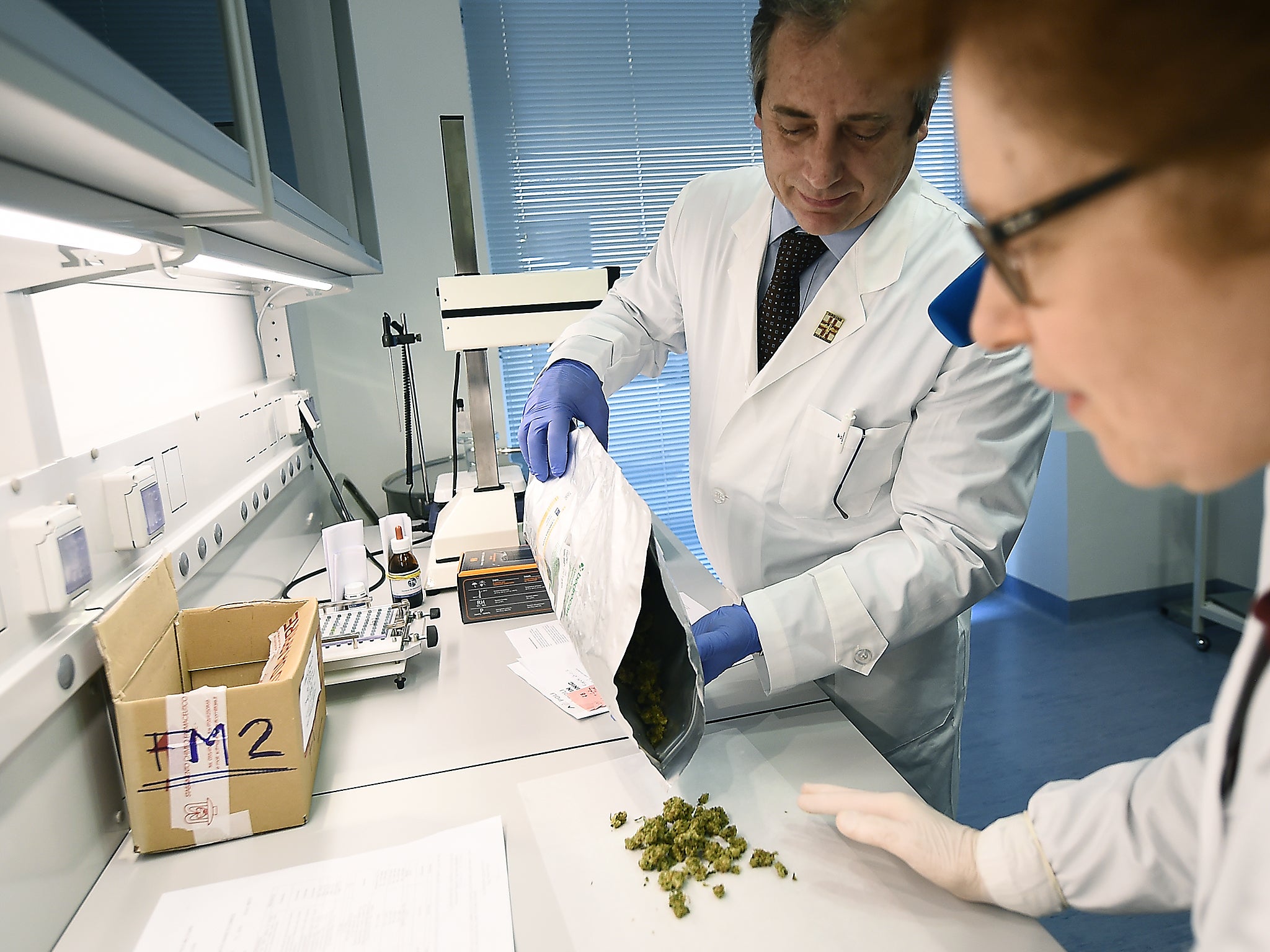There is legal marijuana in the UK – so why is it hard to get hold of?
Seven years after the first cannabis-based pharmaceutical was made available in the UK - which helps Multiple Sclerosis suffers - it still costs more than £375 for around 270 doses

Your support helps us to tell the story
From reproductive rights to climate change to Big Tech, The Independent is on the ground when the story is developing. Whether it's investigating the financials of Elon Musk's pro-Trump PAC or producing our latest documentary, 'The A Word', which shines a light on the American women fighting for reproductive rights, we know how important it is to parse out the facts from the messaging.
At such a critical moment in US history, we need reporters on the ground. Your donation allows us to keep sending journalists to speak to both sides of the story.
The Independent is trusted by Americans across the entire political spectrum. And unlike many other quality news outlets, we choose not to lock Americans out of our reporting and analysis with paywalls. We believe quality journalism should be available to everyone, paid for by those who can afford it.
Your support makes all the difference.It’s around this time of year that weed smokers get their time in the hazy sun. Cases get put forward, people get high, and then the legalisation chorus dissipates into the background for another year. But cannabis has been available in medical form for seven years now in the UK, though you probably didn’t know that, and that’s emblematic of the issue.
GW Pharmaceutical’s cannabis-derived prescription drug, Sativex, is popular with sufferers of Multiple Sclerosis, but it’s expensive. In 2014, NICE (The National Institute for Health and Care Excellence) found it not sufficiently effective in treating muscle spasticity for its price. In 2017, it costs £375 + VAT per pack, roughly 270 doses.
That decision meant the drug, administered as a spray under the tongue, isn’t available in England and Scotland on the NHS. In Wales, there’s limited availability. MS sufferers here are only permitted the drug to control spasms, not to relive pain, once they’ve exhausted other medical options.
Why is the first cannabis-based pharmaceutical available in the UK so expensive? Why is it so hard to get? And what does this mean for UK cannabis prohibition?
Caths Evans is a Tumefactive multiple sclerosis sufferer and founder of the Sativex Advisory Group (SAG). Evans told me how traditional medicines made her feel sick all the time, “like a zombie.” Evans’ condition is characterised by spasms and infrequent strokes, years apart, which have had an impact on her mobility, memory and ability to speak.
Sativex – which she’s been prescribed since 2010, luckily predating NICEs decision – aided her symptoms dramatically. “[Before] I had this feeling down my left side like my body didn’t belong to me… It’s like a tingling sensation; anything cold would be painful on my skin. Rain was painful. Hot water was lukewarm to me. I would take things out of the oven without using gloves; it was quite dangerous for a time.
“But once I started using Sativex, it was amazing! The tingling had stopped almost, the spasms stopped completely. You weren’t out of your head on it; it just made you feel normal.”

Crucially for Evans, Sativex is still not half as readily available as it should be due to NICEs decision, and also because Sativex is only made available for MS sufferers in the UK, though it aids symptoms in other illnesses.
The price of the drug is unlikely to be an issue of pure unadulterated capitalism. Peter Reynolds, President of CLEAR (Cannabis Law Reform), told me the main reason the price is so high is because “the process GW had to go through in order to achieve market authorisation is so expensive.”
But according to an MS Trust spokesperson, Sativex has always been scarce: “The local CCG tended to be reluctant to prescribe [pre-2014], though that might have been down to the reluctance of CCGs to prescribe things without any NICE guidance, and they came out against it, which obviously closed it down entirely.” In medical trials, around half of the patients responded, typically in the first few weeks of treatment.
It comes as little surprise to anyone familiar with the pharmaceutical world that the cost of research, development and marketing ratchets up the cost of a drug. The issue is suspect however when you consider Sativex and its counterparts internationally are much more affordable. The difference in the UK, of course, is that possession of cannabis – a controlled, Class B drug – could see you charged under the 1971 Misuse of Drugs Act, although figures suggest an anaemic national police force pursues this course less than ever.
The price likely stems from the added regulatory hoops Sativex must pass through in Britain, as, according to Reynolds: “The exact replica of Sativex can be bought in medical marijuana dispensaries in the States for a tiny fraction of the price that GW Pharmaceutical charge for it,” as they don’t have to comply with the same regulatory procedures.
GWs Vice President of Investor Relations, Stephen Schultz, argues it’s not the parent company’s fault for the price discrepancy, nor is it avoidable, as another pharmaceutical company, Almirall, markets Sativex and “each country has its own pricing scheme”.
Sativex is not currently available in the US, as it’s not FDA-approved, though it is in phase 3 trialling.
In Reynolds’ view, it’s the procedures the Medicines and Healthcare products Regulatory Agency (MHRA) and other regulatory bodies use to test new drugs that are the issue. “The whole way Sativex is regulated is fundamentally dishonest. It’s regulated on the basis that it consists of only 2 molecules: THC and CBD. Whilst Dr Geoffrey Guy, the Chairman of GW, is on the record himself saying – I have it confirmed in writing from him – that it contains up to 400 molecules.
“The MHRA and conventional or pharmaceutical medicines regulators are simply not competent, capable of regulating a whole plant medicine.
“Every other jurisdiction in the world has set up special regulatory procedures around cannabis because it is completely different from pharmaceutical medicines.”
In real, consequential ways, GW is trailblazing in a particularly fledgling and legally dodgy area in UK medicine. For Reynolds, it’s all for the better: “I’m a great admirer of GW... I regard them as the people who, at great courage, and at great risk, have broken the UK cannabis prohibition. By playing the Governments game, by going through the established procedures.”
There’s an inherent tension in GWs founding motives, in that they recognise the therapeutic value in cannabis, but their niche exists only if cannabis remains prohibited. So it’s surely not in their interests the British Government affects any law change, is it?
Schultz told me the situation in the US disproves that. ”In the US, we don’t see the relaxation of laws around the medical use of cannabis or recreational use of cannabis as really being any significant impact on our objectives.
“There are those who will use medical dispensary-based marijuana products [in the US], but we believe that most physicians and most patients desire a pharmaceutical medicine,” said Schultz. “Our objective is just to provide that option.”
Speaking with Caths Evans and other MS sufferers, it’s clear Sativex has been incredibly helpful in aiding symptoms such as muscle spasticity, whilst the drug doesn’t bring a host of negative side effects like typical MS pharmaceuticals tend to.
But availability continues to be a fundamental stumbling block for patients in the UK, particularly in England, and that’s a travesty for those that need it. The drug provides compelling evidence of the medicinal efficacy of cannabinoids, though in the UK at least it hasn’t led to a wider medicinal cannabis framework, but it provides reason to hope.
With Sativex, it’s as if cannabis has been repackaged and delivered in a bottle – arguably to circumvent the Home Office’s blanket denial of cannabis’s medicinal worth – but it still hasn’t been enough. Seemingly thanks to powers beyond GWs control, Sativex has largely failed to leave its mark seven years on.
@Nick_ThompsonOG
Join our commenting forum
Join thought-provoking conversations, follow other Independent readers and see their replies
Comments